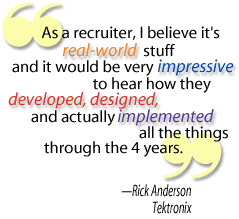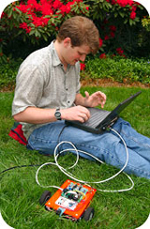TekBots
The School of Electrical Engineering and Computer Science (EECS) is making a fundamental change in the way we teach engineering concepts to students. We're innovating teaching and learning by energizing the curriculum with exciting, hands-on platforms for learning.® Our aim is to put the fun and excitement into EECS and thus retain and inspire interest among students in engineering. Unique to Oregon State and seed-funded by Tektronix, this program helps students understand how class content is interconnected. It also gives them hands on experience in applying theoretical concepts to their robots, turning theories into realities.
Platforms for Learning
The PFL program:
- Integrates courses in the curriculum

The platform provides the conceptual "glue" between lecture topics. When using the platform, lecture topics are related to or discussed in the context of the platform. This holds true if the context is one class or the entire curriculum. Interaction between topics becomes clear when viewed from the perspective of the platform. - Enhances lecture and lab understanding
A platform for learning complements the existing structure of lecture and lab, it makes lecture topics more concrete and active and meshes them with lab experiences.The platform provides a context for learning by connecting the knowledge gained in different classes, developing innovative skills and enhancing knowledge integration for solving complex problems. - Creates a sense of personal ownership and pride
The learning platform should be personally owned. As a student progresses through a curriculum, they will make a considerable investment of time and money in it. When students have ownership for their platform, they also take more ownership for their learning. As a result, they tend to interact with their classmates seeking advice and mentoring as well as working with others to share what they have learned. - Extends to a variety of disciplines
A platform for learning can take many different forms. It can apply to many majors, such as electrical engineering, computer science, and business administration. For an electrical engineering student, the platform may be a very simplistic mobile base that illustrates the operation and construction of basic electronics. For a computer science student, a single-chip "computer" with no pre-defined brains may serve as a learning platform. The point is that there must be an intensive interaction between student and platform so that the student has personal ownership of the platform.
- Emulates professional practice in the real-world
The platform is a real project that creates an atmosphere similar to a large engineering team. The team community sets the stage for the students to engage in formulating and evaluating questions, conjectures, and explanations, just as professional engineers would in the workplace. This is in stark contrast to the often boring, contrived and sanitized exercises found at the end of the chapter which have no loose ends or real constraints and which typically have only one correct solution.

- Promotes flexible and effective innovation
A flexible platform encourages innovation by making new creations a natural extension of what has been done previously. It is the flexibility that allows the platform to be accessible. If the learning platform is located in a laboratory, the opportunity for experimentation and innovation is lost. The optimum situation is where the platform is available any time and anywhere.